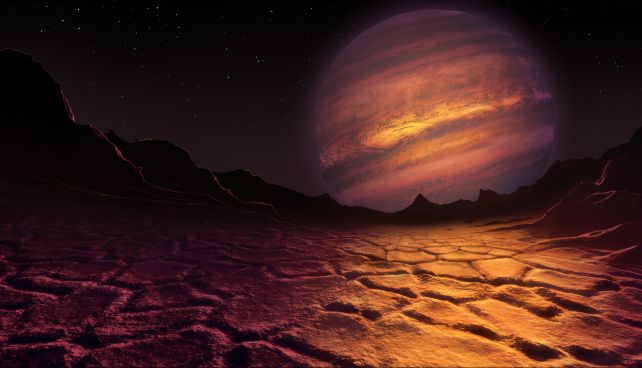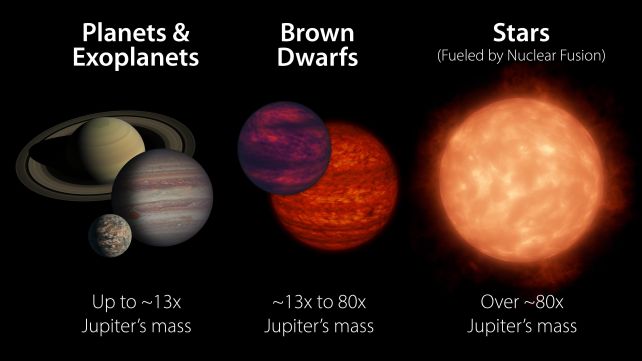A record-breaking binary system has been found with a rotation so tight, both objects could comfortably fit inside the Sun.
Called ZTF J2020+5033, its just 457 light-years away and consists of a high-mass brown dwarf and a low-mass red dwarf that spin around each other on a dizzying 1.9-hour orbit. That's the closest orbit a brown dwarf has been found in yet by over a factor of 7, making the distance between the two objects less than half of the Sun's radius.
Very few brown dwarfs have been found in close binaries with other small stars. ZTF J2020+5033, according to a team led by astrophysicist Kareem El-Badry of the Harvard-Smithsonian Center for Astrophysics, could offer us some clues as to why.
The discovery has been submitted to The Open Journal of Astrophysics, and is available on preprint server arXiv.
Brown dwarfs, technically, don't fall under the definition of stars, occupying the not-quite-either zone between tiny stars and massive planets. Roughly between 13 and 80 times the mass of Jupiter, they're massive enough to ignite fusion of deuterium in their cores, but not the hydrogen that powers full stars.

Being rather small and dim, they're difficult to spot. We know of around 5,000 brown dwarfs out there in the Milky Way, and most of those are isolated, just hanging out on their own. Only about 1 percent of Sun-like and lower mass stars are in binaries with brown dwarfs within a few astronomical units.
Nevertheless, these binaries are sought by astronomers. Paired brown dwarfs that are interacting with a companion star can help us measure their properties and better understand their formation and evolution.
El-Badry and his colleagues went looking for low-mass binaries that might include a brown dwarf using the Zwicky Transient Facility, and discovered ZTF J2020+5033. Follow-up study using various datasets, including data from Gaia, allowed them to obtain precision measurements of the system, and confirm its characteristics.

The system's red dwarf is also relatively small – just 17.6 percent of the radius and 13.4 percent of the mass of the Sun.
The brown dwarf, on the other hand, is right on the edge of the upper mass limit for these enigmatic objects: it's around the radius of Jupiter, but 80.1 times its mass.
Other properties suggest that both objects are also pretty old, which raises questions about how they got to where they are. El-Badry and his colleagues believe both objects would have once been considerably larger than they are, implying that they were once at least 5 times more distant from each other.
When material from the star escapes, it is slowed by the star's magnetic field a considerable distance before it finally escapes. Just as a spinning ice skater slows by extending their arms, this mass distribution slows the star's spin, which shrinks the orbit in the case of binaries. Based on the tight orbit in this binary system, such 'magnetic braking' appears to be an efficient process, even in low-mass stars and brown dwarfs.
This means that, in the future, ZTF J2020+5033's orbit should continue to shrink. Although it is smaller and less massive than the red dwarf, the brown dwarf has slightly higher surface gravity; this in turn means that the brown dwarf will start to steal material from the red dwarf as they draw closer together.
If magnetic braking is playing a role in the decaying orbit, this mass transfer should start within a few tens of millions of years. We won't be around to see it, but the discovery of the system, so close to us, suggests that these close low-mass binaries are relatively common. We just may not have found many because they're so dim.
However, our improving telescope technology may reveal them to us, very soon, allowing scientists to make a more in-depth study of magnetic braking in tiny stars.
The research has been submitted to The Open Journal of Astrophysics and is available on arXiv.
"fit" - Google News
August 03, 2023 at 09:00AM
https://ift.tt/LKut6WY
These Two Stars Orbit So Close, The Entire System Would Fit Inside Our Sun - ScienceAlert
"fit" - Google News
https://ift.tt/GqJvNxe
https://ift.tt/lzvQtfH
Bagikan Berita Ini














0 Response to "These Two Stars Orbit So Close, The Entire System Would Fit Inside Our Sun - ScienceAlert"
Post a Comment